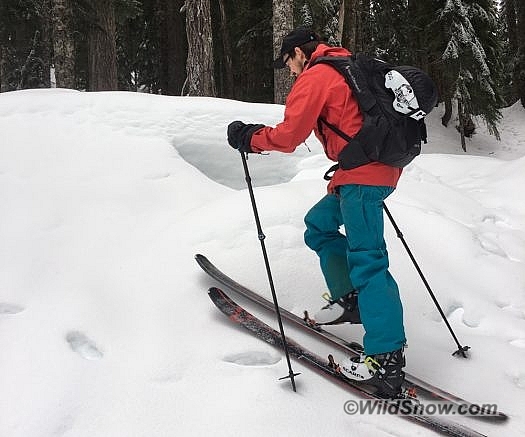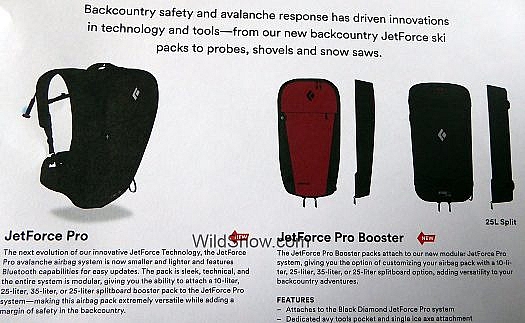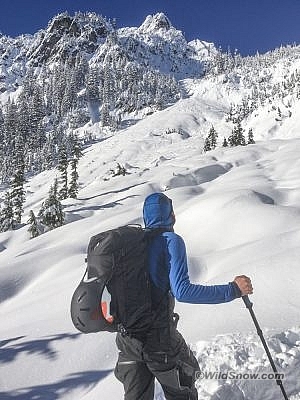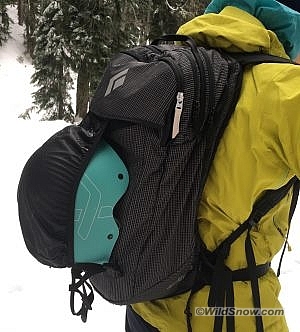This post sponsored by our publishing partner Cripple Creek Backcountry.
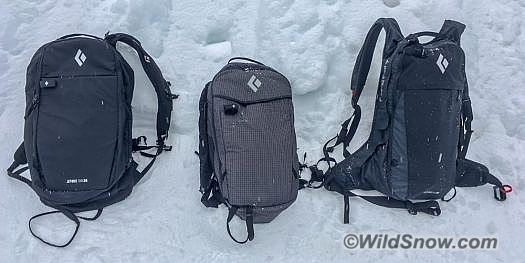
Three different approaches to airbag technology. From left to right: JetForce Tour26L, JetForce UL, JetForce Pro (with 10L booster).
This year, Black Diamond steps out guns ablazin’ with their snowsports airbag packs. Not content to try and hit the mark with one airbag system, they opted for the shotgun: three different types of rucksacks, using three different types of airbag systems. (Note, the only pack in this review that’s currently available is the JetForce Tour 26L, the other two packs will begin retail fall of 2019.)
The line comprises several models, utilizing three types of airbag technology. The JetForce Pro pack uses the JetForce airbag electronics, designed by BD and significantly improved this year. The JetForce Tour line uses Alpride’s E1 capacitor technology. Last, and least (in terms of weight), is the JetForce UL line, which uses the Alpride compressed gas system. Confusing? Yes. So we’ll call that actual JetForce battery/fan system the “JetForce electronics” or something like that.
Initially I thought three different airbag systems from one manufacturer was overkill for our ski touring community. Not so. Each one excels in areas the others don’t. Until we get the “holy grail” of airbag tech (and agree on what exactly that is), that’s the way it is going to be — like tech bindings, expect to see dozens if not hundreds of airbag backpack options become available. Here’s a brief overview of the BD options, and what they’re good for.
Jetforce Pro is the Tesla of the line, and not only because it’s electric. It’s beautifully designed, high tech, packed with features, and… expensive at MSRP $1,399.95.
The Pro line consists of one “base” pack, that contains the JetForce electronic airbag components, and several zip-on packs (called “boosters”) that can be attached to the base, to make packs of different volumes. Initially BD will offer a 10 liter, 35 liter, and two 25 liter booster packs. The Pro system is a direct descendant of Black Diamond’s original JetForce electronic airbag system, which was introduced several years ago, and was the first electric fan pack to get on the market. The updated version keeps the same DNA, but updates the system in a few ways. Most importantly, it is significantly about two pounds lighter! Other updates are Bluetooth connectivity (for updating the firmware), and a simplified birthing zipper.
Being a “fan” pack, JetForce Pro solves many of the issues associated with compressed gas packs: Easy to travel with; easy to recharge; can be deployed multiple times; easy to see indications for when it’s on and ready. Also, the airbag is 200 liters, bigger than many other airbags, which are usually 150 liters. Although not integral to the JetForce Pro system design, the modularity of the zip-off booster packs is another important feature, allowing you to buy one expensive base unit and have several different size packs.
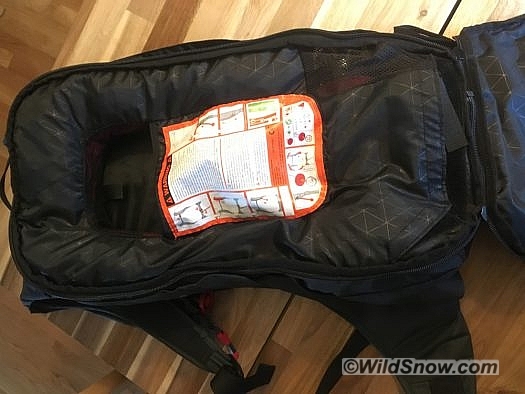
Open pack showing airbag components and interior. As you can see, the JetForce Pro is fairly bulky, and takes up quite a bit of room in the pack.
The main drawback of the feature-rich JetForce Pro is it’s gravity altering effects; it simultaneously makes your wallet lighter and your pack heavier. We’ve been testing the 10 liter version of the pack, expect a review soon.
JetForce Pro specs:
JetForce Tour is the next step down from the Pro, in both weight and complexity. This pack is currently available. The Tour utilizes Alpride’s E1 system. The E1, introduced last year, is the first capacitor based electric fan airbag system. Don’t worry, I don’t understand the difference between a capacitor and a battery is either, perhaps His Blogness does? The important thing is that capacitors are good at discharging lots of energy quickly, which is perfect for an airbag.
The E1 has significant advantages over any other airbag system. It’s the easiest to recharge, either from a usb, or with AA batteries, and to travel with, as capacitors are even less restricted than lithium batteries. It’s also the lightest electric fan system yet.
The JetForce Tour is unabashedly my favorite of the bunch for ski touring. However, it isn’t without its drawbacks. Compared to the Pro, it is significantly less user friendly. You turn the system on and off using a switch inside the pack, and the indicator lights are located on the side of the pack. This means you can’t turn the system on or off without opening up your pack, and you can’t see if it’s on or off without taking your pack off or asking someone to take a look. “Hey, is my airbag blinking?”
Also, it doesn’t feature the Bluetooth diagnostic capabilities of the Pro. There’s some compromises likely made for weight reasons; the airbag is an industry standard 150 liters, and doesn’t deflate automatically like the Pro does. We’ve been using the 26 liter version extensively, expect a review soon. Compared to the JetForce UL, the system is simply heavier.
26 liter JetForce Tour weight: 2630 grams (5.7 lbs), MSRP $1199.95
JetForce UL is light, just like it sounds. The 26 liter pack is only 1991 grams. The pack uses Alpride’s original gas system, which is unique in that it uses two small gas cylinders (argon and Co2) that, again, are not refillable. The advantages of the pack are simple, but not insignificant: lightest in the line and the cheapest at MSRP $849.95
The UL does have its downsides. It’s still somewhat difficult to travel with due to confusion as to whether the cartridges should be in checked baggage or carried on, as well as if they should be inserted into the pack. The initial low cost is offset a bit if you have to buy new cylinders, which cost $50 for a set, and can only be used once (not refillable). Like any compressed gas system, if you test it, it has to be reset, and there’s no other way of verifying that it’s functional other than to fire it. (Why is it we keep gravitating to the electronic systems?)
So that’s the different airbag systems that Black Diamond is or soon will be retailing. Asside from the plumbing, the designs of the backpacks themselves are significantly different from one line to the next. This will affect your shopping decision. We’ll go into more detail on each pack in individual reviews. For now, know that BD is not messing around!
Louie Dawson earned his Bachelor Degree in Industrial Design from Western Washington University in 2014. When he’s not skiing Mount Baker or somewhere equally as snowy, he’s thinking about new products to make ski mountaineering more fun and safe.

